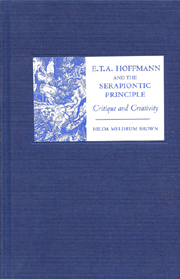Book contents
- Frontmatter
- Contents
- List of Illustrations
- Preface
- Acknowledgments
- List of Abbreviations
- Introduction: Approaches to the Serapiontic Principle
- Part 1
- Part 2
- 7 Frame Narrative and the Serapiontic Principle
- 8 From Visual to Verbal: Three Serapiontic Tales
- 9 The “Nachtseite der Natur” and the Serapiontic Principle
- 10 The Märchen and the Serapiontic Principle
- 11 The Serapiontic Principle: The Wider Critique
- Conclusion
- Select Bibliography
- Index
10 - The Märchen and the Serapiontic Principle
from Part 2
Published online by Cambridge University Press: 05 February 2013
- Frontmatter
- Contents
- List of Illustrations
- Preface
- Acknowledgments
- List of Abbreviations
- Introduction: Approaches to the Serapiontic Principle
- Part 1
- Part 2
- 7 Frame Narrative and the Serapiontic Principle
- 8 From Visual to Verbal: Three Serapiontic Tales
- 9 The “Nachtseite der Natur” and the Serapiontic Principle
- 10 The Märchen and the Serapiontic Principle
- 11 The Serapiontic Principle: The Wider Critique
- Conclusion
- Select Bibliography
- Index
Summary
Introduction
Hoffmann's Serapionsbrüder are in agreement about the general suitability of the Supernatural — whether malign or benign — as material for the imaginative processing of sense data, which is a characteristic feature of the Serapiontic principle in art, while being sharply divided on the question of the extent to which malign forces can be in control of human destiny. This distinction between the different functions of the Supernatural was, of course, also discernible right from the start of the Serapionsbrüder collection in the members's various interpretations of the complex signals emanating from the Einsiedler tale, in which the hermit'ss success as a teller of tales was bought at the price of recognition or acceptance of the fundamental dichotomies that characterize human life. The tales associated with the “Nachtseite” featured, through their main characters Elis and Cardillac, the tortured psychology of characters whose subconscious urges — triggered by external circumstances — would dominate their lives and in each case lead to their destruction, albeit in Das Fräulein von Scuderi the misery of Cardillac'ss situation is partially counterbalanced by the reassuring image of the court poetess. This character, the précieuse Mlle de Scudéry, is treated sympathetically, though not without irony, and reveals courage and resourcefulness in helping, at one level of the tale, to bring about a happy end culminating in the union of the young lovers.
As for the Märchen, Hoffmann makes it clear from the frame discussions that he is working with a form that is well-established in the Romantic tradition but that he intends to develop very much in the spirit of the Serapiontic program.
- Type
- Chapter
- Information
- E. T. A. Hoffmann and the Serapiontic PrincipleCritique and Creativity, pp. 169 - 184Publisher: Boydell & BrewerPrint publication year: 2006

